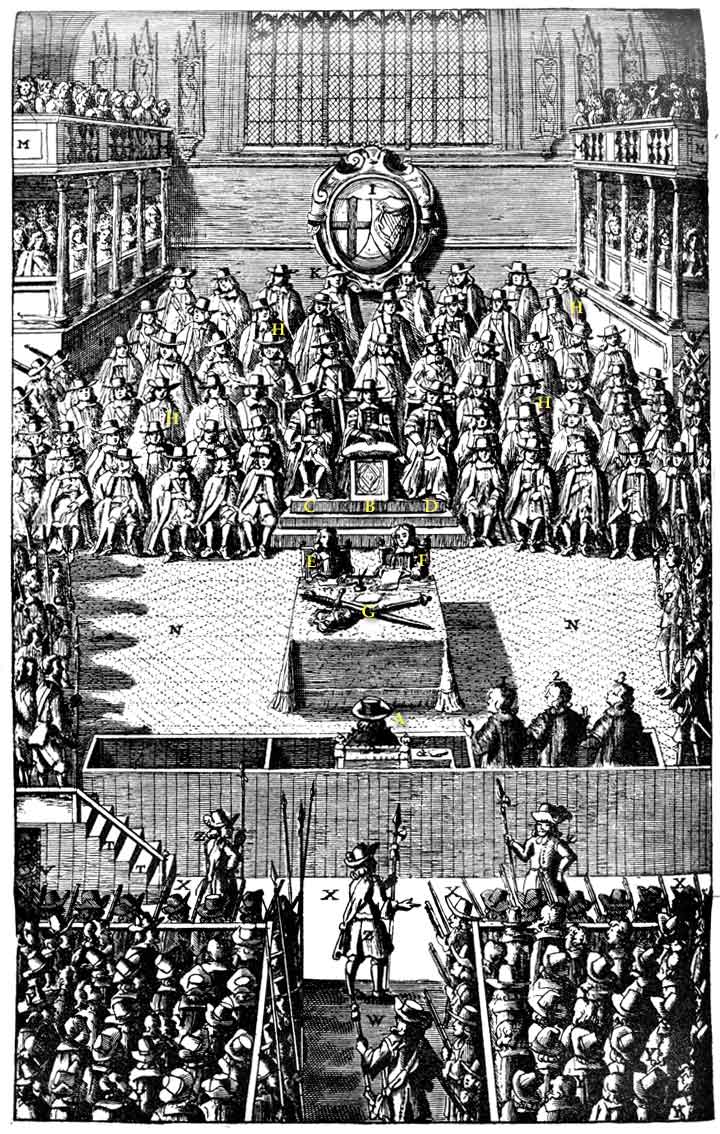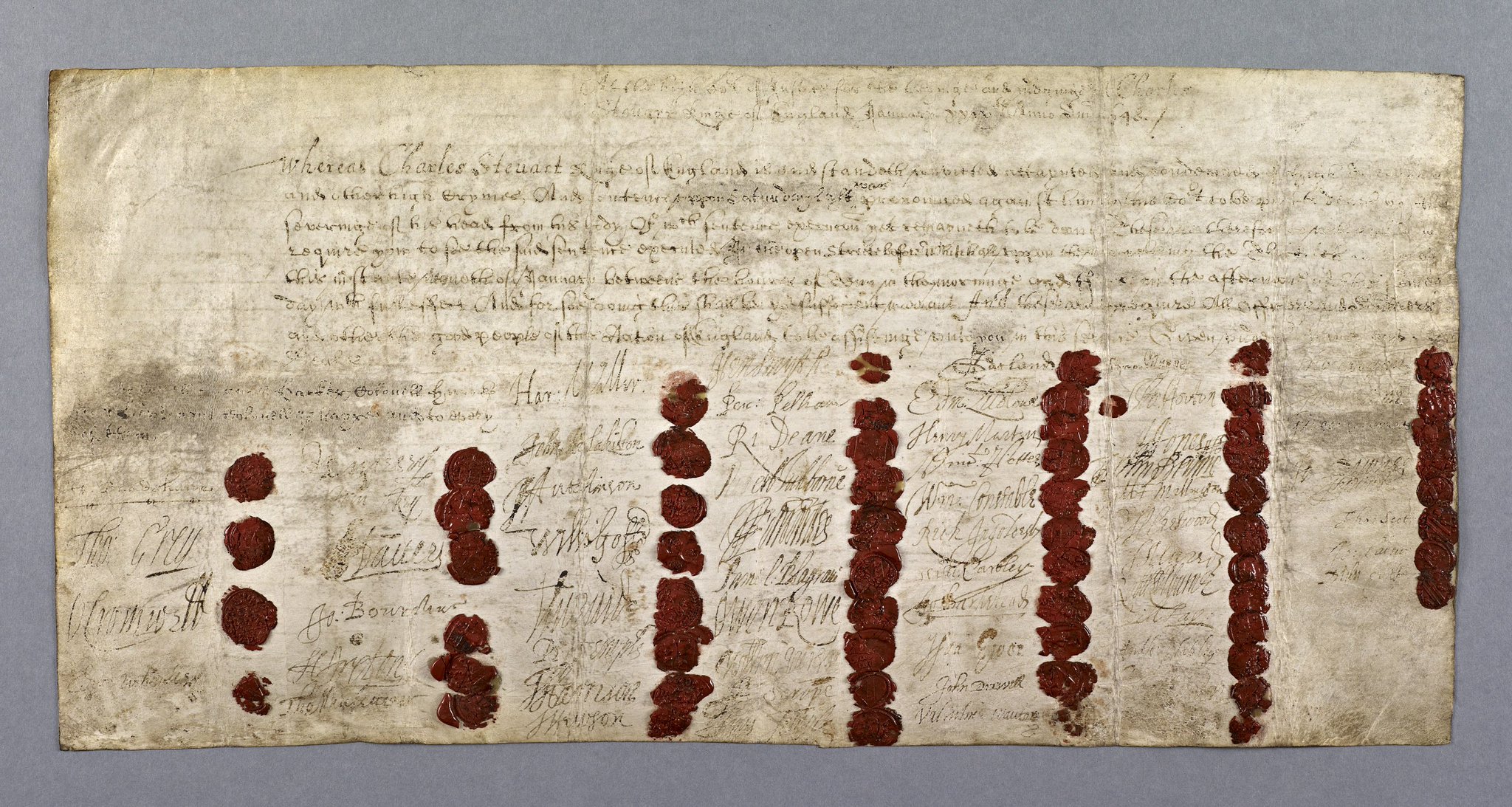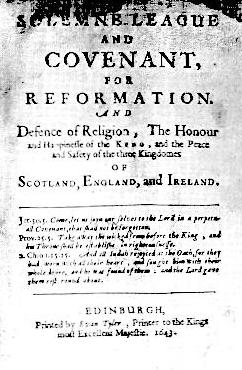|
Anthony Stapley
Anthony Stapley (born 30 August 1590 – buried 31 January 1655) was one of the regicides of King Charles I of England. Stapley was M.P. for New Shoreham (1624–1625), Lewes (1628), Sussex (1640, 1653–1654). He was colonel and governor of Chichester (1642–1645) and signed the death-warrant of Charles I. He was a member of Council of State in 1649–1653, vice-admiral of Sussex in 1650 and a member of interim council and of supreme assembly in 1653. Biography Stapley was baptised at Framfield on 30 August 1590, was the son of Anthony Stapley of Framfield, Sussex, by his third wife, Ann, daughter of John Thatcher of Priesthawes, Sussex. The Stapley family removed about 1615 from Framfield to Patcham. Anthony about 1640 gave £10 to the new building at Christ's College, Cambridge, and was probably educated there. Stapley represented the borough of New Shoreham in the parliaments of 1624 (elected 21 January 1624) and of 1625 (elected 2 May), and the borough of Lewes in that ... [...More Info...] [...Related Items...] OR: [Wikipedia] [Google] [Baidu] |
Brackets
A bracket is either of two tall fore- or back-facing punctuation marks commonly used to isolate a segment of text or data from its surroundings. Typically deployed in symmetric pairs, an individual bracket may be identified as a 'left' or 'right' bracket or, alternatively, an "opening bracket" or "closing bracket", respectively, depending on the Writing system#Directionality, directionality of the context. Specific forms of the mark include parentheses (also called "rounded brackets"), square brackets, curly brackets (also called 'braces'), and angle brackets (also called 'chevrons'), as well as various less common pairs of symbols. As well as signifying the overall class of punctuation, the word "bracket" is commonly used to refer to a specific form of bracket, which varies from region to region. In most English-speaking countries, an unqualified word "bracket" refers to the parenthesis (round bracket); in the United States, the square bracket. Glossary of mathematical sym ... [...More Info...] [...Related Items...] OR: [Wikipedia] [Google] [Baidu] |
William Laud
William Laud (; 7 October 1573 – 10 January 1645) was a bishop in the Church of England. Appointed Archbishop of Canterbury by Charles I in 1633, Laud was a key advocate of Charles I's religious reforms, he was arrested by Parliament in 1640 and executed towards the end of the First English Civil War in January 1645. A firm believer in episcopalianism, or rule by bishops, "Laudianism" refers to liturgical practices designed to enforce uniformity within the Church of England, as outlined by Charles. Often highly ritualistic, these were precursors to what are now known as high church views. In theology, Laud was accused of Arminianism, favouring doctrines of the historic church prior to the Reformation and defending the continuity of the English Church with the primitive and medieval church, and opposing Calvinism. On all three grounds, he was regarded by Puritan clerics and laymen as a formidable and dangerous opponent. His use of the Star Chamber to persecute opponents su ... [...More Info...] [...Related Items...] OR: [Wikipedia] [Google] [Baidu] |
Charles II Of England
Charles II (29 May 1630 – 6 February 1685) was King of Scotland from 1649 until 1651, and King of England, Scotland and Ireland from the 1660 Restoration of the monarchy until his death in 1685. Charles II was the eldest surviving child of Charles I of England, Scotland and Ireland and Henrietta Maria of France. After Charles I's execution at Whitehall on 30 January 1649, at the climax of the English Civil War, the Parliament of Scotland proclaimed Charles II king on 5 February 1649. But England entered the period known as the English Interregnum or the English Commonwealth, and the country was a de facto republic led by Oliver Cromwell. Cromwell defeated Charles II at the Battle of Worcester on 3 September 1651, and Charles fled to mainland Europe. Cromwell became virtual dictator of England, Scotland and Ireland. Charles spent the next nine years in exile in France, the Dutch Republic and the Spanish Netherlands. The political crisis that followed Cromwell's death in 1 ... [...More Info...] [...Related Items...] OR: [Wikipedia] [Google] [Baidu] |
John Stapley
Sir John Stapley, 1st Baronet of Patcham (1628–1701) was an English politician who sat in the House of Commons at various times between 1654 and 1679. He was a Royalist who plotted with members of the Sealed Knot to overthrow the Protector Oliver Cromwell and restore Charles II of England to the throne, but when questioned by Cromwellians he disclosed the plot and betrayed the other members. After the Restoration, he was created a baronet on 28 July 1660.Porter, DNB, LIV, p. 105 Biography Stapley was the second but eldest surviving son, of Anthony Stapley of Patcham and his wife Ann Goring, daughter of George Goring of Danny, and sister of George, Lord Goring. He was baptised at Patcham on 29 June 1628. His father was one of the Regicides of Charles I of England and member of the Council of State under the Commonwealth In 1654, Stapley was elected Member of Parliament for Sussex in the First Protectorate Parliament. In January 1656 he was appointed Deputy Lieutenant of Susse ... [...More Info...] [...Related Items...] OR: [Wikipedia] [Google] [Baidu] |
George Goring, Lord Goring
George Goring, Lord Goring (14 July 1608 – 1657) was an English Cavalier, Royalist soldier. He was known by the Courtesy titles in the United Kingdom, courtesy title ''Lord Goring'' as the eldest son of the George Goring, 1st Earl of Norwich, first Earl of Norwich. Early life Goring, the eldest son of George Goring, 1st Earl of Norwich, was born on 14 July 1608. He married Lettice Boyle, the daughter of Richard Boyle, 1st Earl of Cork. Experience before the Civil Wars His father-in-law, Richard Boyle, 1st Earl of Cork, procured for him a post in the Royal Netherlands Army#1572 to 1814, Dutch Army with the rank of colonel. He was permanently lamed by a wound received at the Siege of Breda (1637), Siege of Breda in 1637, and returned to England early in 1639, when he was made governor of Portsmouth. He served in the Bishops' Wars, and already had a considerable reputation when he was involved in the "First Army Plot, Army Plot" (1641). Officers of the army stationed at ... [...More Info...] [...Related Items...] OR: [Wikipedia] [Google] [Baidu] |
Act Of Pardon And Oblivion
The Indemnity and Oblivion Act 1660 was an Act of the Parliament of England (12 Cha. II c. 11), the long title of which is "An Act of Free and General Pardon, Indemnity, and Oblivion". This act was a general pardon for everyone who had committed crimes during the English Civil War and subsequent Commonwealth period, with the exception of certain crimes such as murder (without a licence granted by King or Parliament), piracy, buggery, rape and witchcraft, and people named in the act such as those involved in the regicide of Charles I. It also said that no action was to be taken against those involved at any later time, and that the Interregnum was to be legally forgotten. An act of free and general pardon, indemnity and oblivion History The Indemnity and Oblivion Act fulfilled the suggestion given in the Declaration of Breda that reprisals against the establishment which had developed during the English Interregnum would be restricted to those who had officiated in the regicide ... [...More Info...] [...Related Items...] OR: [Wikipedia] [Google] [Baidu] |
Patcham
Patcham () is an area of the city of Brighton & Hove, about north of the city centre. It is bounded by the A27 (Brighton bypass) to the north, Hollingbury to the east and southeast, Withdean to the south and the Brighton Main Line to the west. The A23 passes through the area. History Patcham was originally a separate village that developed around the partly 12th- and 13th-century All Saints' Church. The parish of Patcham extended to and encompassed large parts of what are now adjacent suburbs, such as Withdean, Westdene, Hollingbury and Tongdean. It extended eastwards into modern-day Moulsecoomb, westwards beyond Dyke Road into Hove, and northwards across the sparsely-populated South Downs towards the parishes of Pyecombe and Ditchling. The centre of the original village, based around the church (on Church Hill) and the Old London Road – now bypassed by the modern A23 – is a conservation area, and several buildings are listed. Modern Patcham Sir Herbert Carden, a promine ... [...More Info...] [...Related Items...] OR: [Wikipedia] [Google] [Baidu] |
High Court Of Justice For The Trial Of Charles I
The High Court of Justice was the court established by the Rump Parliament to try Charles I, King of England, Scotland and Ireland. Even though this was an ''ad hoc'' tribunal that was specifically created for the purpose of trying the king, its name was eventually used by the government as a designation for subsequent courts. Background The English Civil War had been raging for nearly an entire decade. After the First English Civil War, the parliamentarians accepted the premise that the King, although wrong, had been able to justify his fight, and that he would still be entitled to limited powers as King under a new constitutional settlement. By provoking the Second English Civil War even while defeated and in captivity, Charles was held responsible for unjustifiable bloodshed. The secret "Engagement" treaty with the Scots was considered particularly unpardonable; "a more prodigious treason", said Oliver Cromwell, "than any that had been perfected before; because the former qu ... [...More Info...] [...Related Items...] OR: [Wikipedia] [Google] [Baidu] |
List Of Regicides Of Charles I
Following the trial of Charles I in January 1649, 59 commissioners (judges) signed his death warrant. They, along with several key associates and numerous court officials, were the subject of punishment following the restoration of the monarchy in 1660 with the coronation of Charles II. Charles I's trial and execution had followed the second English Civil War in which his supporters, Royalist "Cavaliers", were opposed by the Parliamentarian "Roundheads", led by Oliver Cromwell. With the return of Charles II, Parliament passed the Indemnity and Oblivion Act (1660), which granted amnesty to those guilty of most crimes committed during the Civil War and the Interregnum. Of those who had been involved in the trial and execution, 104 were specifically excluded from reprieve, although 24 had already died, including Cromwell, John Bradshaw (the judge who was president of the court), and Henry Ireton (a general in the Parliamentary army and Cromwell's son-in-law). They were giv ... [...More Info...] [...Related Items...] OR: [Wikipedia] [Google] [Baidu] |
Algernon Sidney
Algernon Sidney or Sydney (15 January 1623 – 7 December 1683) was an English politician, republican political theorist and colonel. A member of the middle part of the Long Parliament and commissioner of the trial of King Charles I of England, he opposed the king's execution. Sidney was later charged with plotting against Charles II, in part based on his most famous work, ''Discourses Concerning Government'', which was used by the prosecution as a witness at his trial. He was executed for treason. After his death, Sidney was revered as a "Whig patriot—hero and martyr". The works of Algernon Sidney, along with those of contemporary John Locke, are considered a cornerstone of western thought. ''Discourses Concerning Government'' cost Sidney his life. However, the ideas it put forth survived and ultimately culminated in the Glorious Revolution in England and the founding of the United States. Sidney directly opposed the theory of divine right of kings by suggesting ideas such ... [...More Info...] [...Related Items...] OR: [Wikipedia] [Google] [Baidu] |
Committee Of Both Kingdoms
The Committee of Both Kingdoms, (known as the Derby House Committee from late 1647), was a committee set up during the Wars of the Three Kingdoms by the Parliamentarian faction in association with representatives from the Scottish Covenanters, after they made an alliance (the Solemn League and Covenant) in late 1643. When the Scottish army entered England by invitation of the English Parliament in January 1644 the Parliamentary Committee of Safety was replaced by an ad hoc committee representative of both kingdoms which, by parliamentary ordinance of 16 February, was formally constituted as the Committee of Both Kingdoms. The English contingent consisted of seven peers and 14 commoners. Its object was the management of peace overtures to, or making war on, the King. It was conveniently known as the Derby House Committee from 1647, when the Scots withdrew. Its influence long reduced by the growth of the army's, it was dissolved by Parliament on 7 February 1649 (soon after the execu ... [...More Info...] [...Related Items...] OR: [Wikipedia] [Google] [Baidu] |
Solemn League And Covenant
The Solemn League and Covenant was an agreement between the Scottish Covenanters and the leaders of the English Parliamentarians in 1643 during the First English Civil War, a theatre of conflict in the Wars of the Three Kingdoms. On 17 August 1643, the Church of Scotland (the Kirk) accepted it and on 25 September 1643 so did the English Parliament and the Westminster Assembly. English Parliament (First Civil War) At the time, the Protestant leaders of the English Parliament were in conflict with King Charles I. Fearing Irish Catholic troops could join the Royalist army, Parliament requested the aid of the Scots. The Presbyterian Covenanters promised their aid, on condition that the Scottish system of church government was adopted in England. This was acceptable to the majority of the English Long Parliament, as many MPs were Presbyterians, while others preferred allying with the Scots to losing the Civil War. After some haggling a document called "'' The Solemn League and Co ... [...More Info...] [...Related Items...] OR: [Wikipedia] [Google] [Baidu] |





.jpg)
